Complete Solutions to Level 2 Subjective of chapter REFRACTION OF LIGHT of Class 12 book with complete answers and questions
| Class 12 | PHYSICS |
| Chapter | REFRACTION OF LIGHT |
| DC PANDEY | Level 2 Subjective |
| Number Of Questions | 21 |
| Academic Year | 2023-24 |
a. Figure (a) shows the optical axis of a lens, the point source of light A, and its virtual image `A^(')` . Trace the rays to find the position of the lens and of its focuses. What type of lens is it?

b. Solve the problem similar to the previous one using Figure.

View Solutiona. Figure (a) shows the optical axis of a lens, the point source of light A, and its virtual image `A^(')` . Trace the rays to find the position of the lens and of its focuses. What type of lens is it?

b. Solve the problem similar to the previous one using Figure.

View SolutionIn Figure, a fish watcher watches a fish through a 3.0 cm thick glass wall of a fish tank. The watcher is in level with the fish, the index of refraction of the glass is `8//5` and that of the water `4//3` .
a. To the fish, how far away does the watcher appear to be ?
b. To the watcher, how far away does the fish appear to be ?

View SolutionA concave spherical mirror with a radius of curvature of `0.2 m` is filled with water. What is the focal length of this system? Refractive index of water is `4//3.`
View SolutionA lens with a focal length of `f=30 cm` produces on a screen a sharp image of an object that is at a distance of `a=40 cm` from the lens. A plane parallel plate with thickness of `d=9 cm` is placed between the lens and the object perpendicular to the optical axis of the lens. Through what distance should the screen be shifted for the image of the object to remain distinct? The refractive index of the glass of the plate is `mu=1.8.`
View SolutionOne side of radius of curvature `R_2=120 cm` of a convexo-convex lens of material of refractive index `mu=1.5` and focal length `f_1=40 cm` is slivered. It is placed on a horizontal surface with silvered surface in contact with it. Another convex lens of focal length `f_2=20 cm` is fixed coaxially `d=10 cm` above the first lens. A luminous point object O on the axis gives rise to an image coincide with it. Find its height above the upper lens.
View SolutionA small object is placed on the principal axis of concave spherical mirror of radius `20 cm` at a distance of `30 cm.` By how much will the position of the image alter only after mirror, when a parallel-sided slab of glass of thickness `6 cm` and refractive index `1.5` is introduced between the centre of curvature and the object? The parallel sides are perpendicular to the principal axis.
View SolutionA thin glass lens of refractive index `mu_2=1.5` behaves as an interface between two media of refractive indices `mu_1=1.4 and mu_3=1.6` respectively. Determine the focal length of the lens for the shown arrangement of radius of curvature of both surfaces `20 cm.`
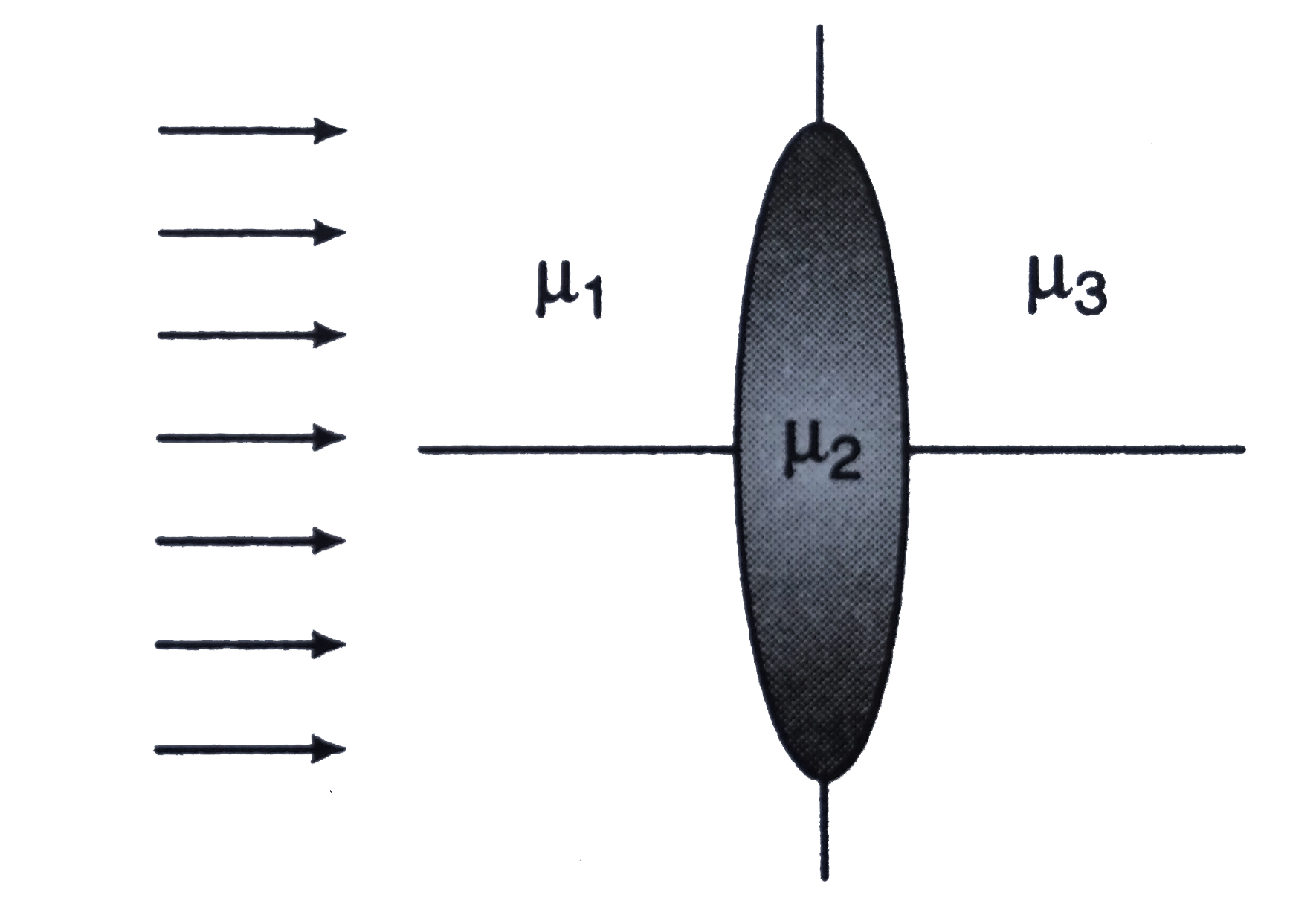
View SolutionA glass hemisphere of radius `10 cm` and `mu=1.5` is silvered over its curved surface. There is an air bubble in the glass `5 cms` from the plane surface along the axis. Find the position of the images of this bubble seen by observer looking along the axis into the flat surface of the atmosphere.
View SolutionA equilateral prism of flint glass `(mu_g=3//2)` is placed water `(mu_w=4//3).`
At what angle should a ray of light fall on the face of the prism so that inside the prism the ray is perpendicular to the bisector of the angle of the prism.
Through what angle will the ray turn after passing through both faces of the prism?
View SolutionRays of light fall on the plane surface of a half cylinder at an angle `45^@` in the plane perpendicular to the axis (see figure). Refractive index of glass is `sqrt2.` Discuss the condition that the rays do not suffer total internal reflection.

View SolutionThe figure shows an arrangement of an equi-convex lens and a concave mirror. A point object O is placed on the principal axis at a distance `40 cm` from the lens such that the final image is also formed at the position of the object. If the radius of curvature of the concave mirror is `80 cm,` find the distance d. Also draw the ray diagram. The focal length of the lens in air is `20 cm.`
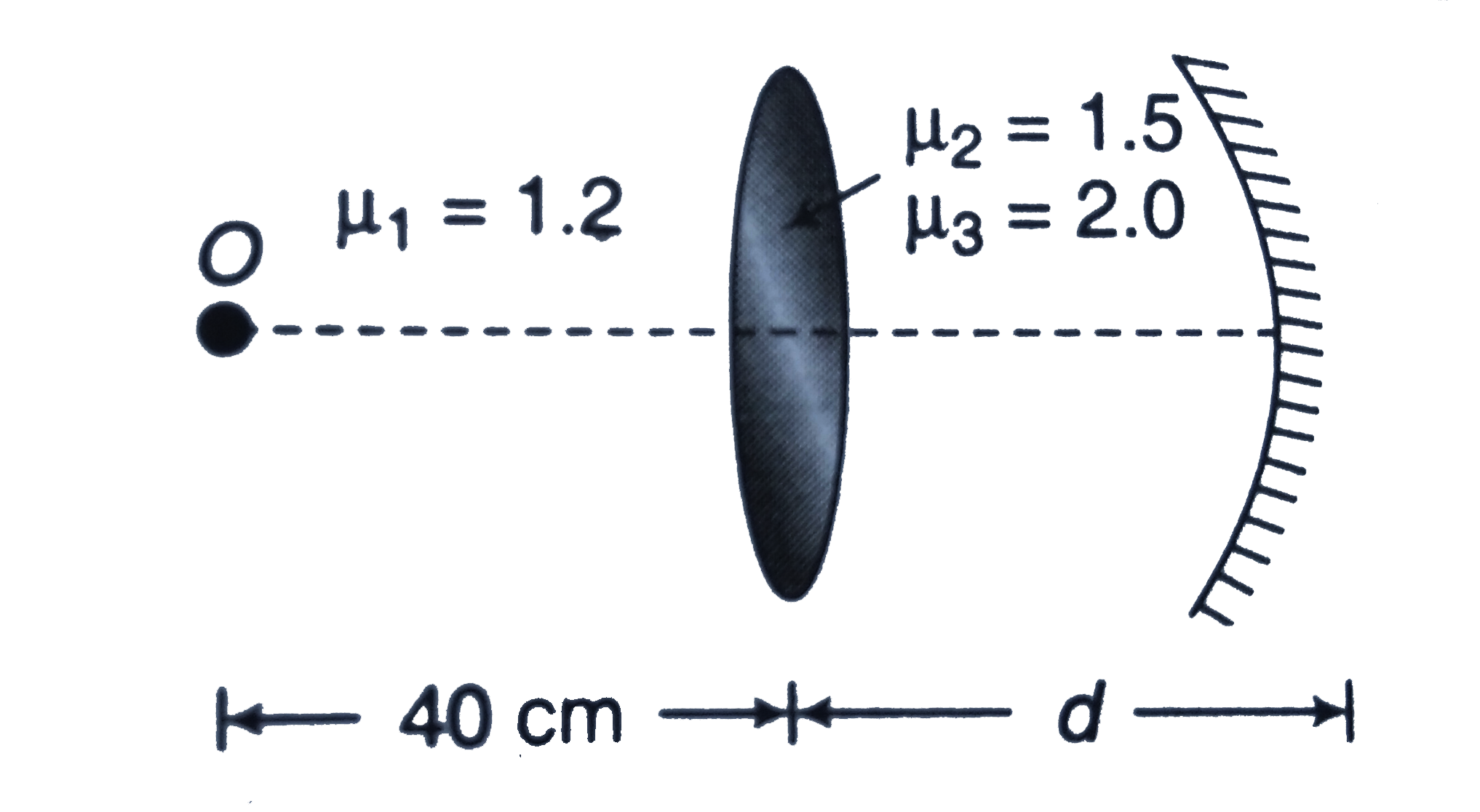
View SolutionA convex lens is held `45 cm` above the bottom of an empty tank. The image of a point at the bottom of a tank is formed `36 cm` above the lens. Now, a liquid is poured into the tank to a depth of `40 cm.` It is found that the distance of the image of the same point on the bottom of the tank is `48 cm` above the lens. Find the refractive index of the liquid.
View SolutionA parallel beam of light falls normally on the first face of a prism of small angle .At the second face it is partly reflected,the reflected beam striking at the first face again, and emerging from it in a direction making an angle `6^(@)` 30' with the reversed direction of the incident beam. The refracted beam is found to have undergone a deviation of `1^@ 15'` from the original direction.Find the refractive index of the glass and the angle of the prism.
View SolutionTwo converging lenses of the same focal length f are separated by a distance 2f. The axis of the second lens is inclined at angle `theta=60^@` with respect to the axis of the first lens. A parallel paraxial beam of light is incident from left side of the lens. Find the coordinates of the final image with respect to the origin of the first lens.

View SolutionA cubical vessel with non-transparent walls is so located that the eye of an observer does not see its bottom but sees all of the wall CD.
To what height should water be poured into the vessel for the observer to see an object F arranged at a distance of `b=10 cm` from corner D? The face of the vessel is `a=40 cm.` Refractive index of water is `4/3.`
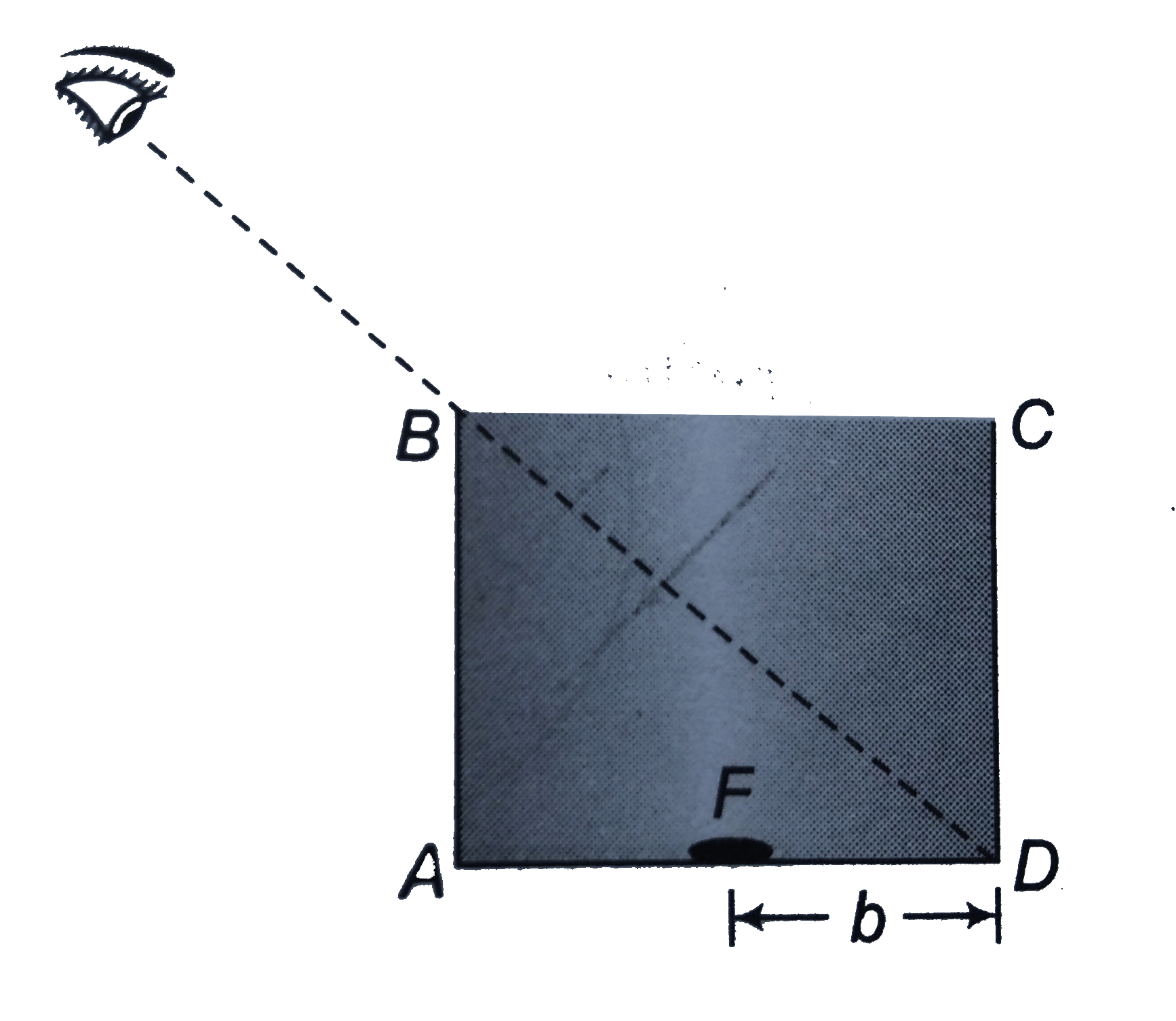
View SolutionA spherical ball of transparent material has index of refraction`mu.` A narrow beam of light AB is aimed as shown. What must the index of refraction be in order that the light is focused at the point C on the opposite end of the diameter from where the light entered? Given that `xgt gtR.`
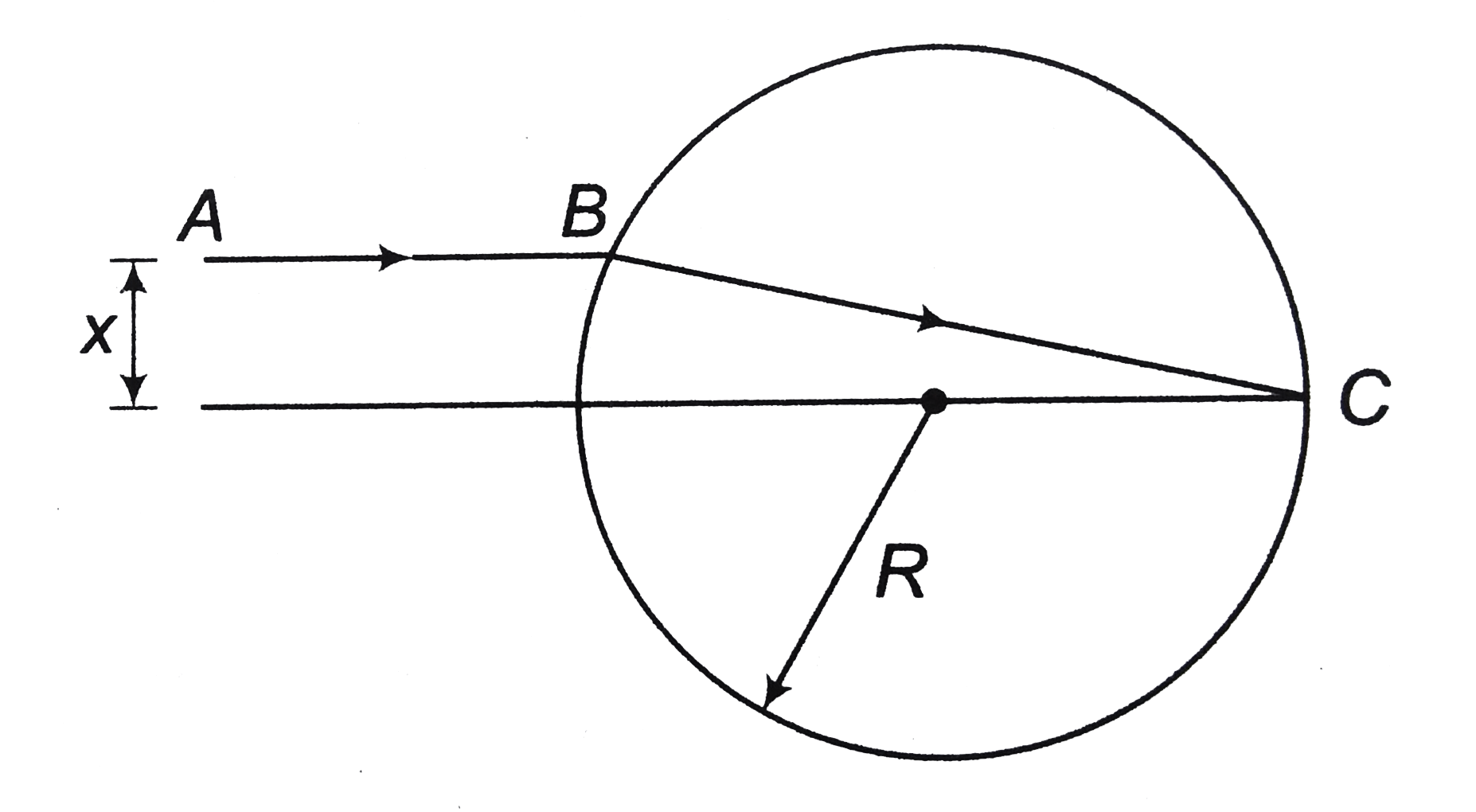
View SolutionA ray incident on the droplet of water at an angle of incidence i undergoes two reflections (not total) and emerges. If the deviation suffered by the ray within the drop is minimum and the refractive index of the droplet be `mu,` then show that `cos i =sqrt((u^2-1))/8.`
View SolutionA transparent solid sphere of radius `2 cm` and density `rho` floats in a transparent liquid of density `2rho` kept in a beaker. The bottom of the beaker is spherical in shape with radius of curvature `8 cm` and is silvered to make it concave mirror as shown in the figure. When an object is placed at a distance of `10 cm` directly above the centre of the sphere C, its final image coincides with it. Find h (as shown in the figure ), the height of the liquid surface in the beaker from the apex of the bottom. Consider the paraxial rays only. The refractive index of the sphere is `3//2` and that of the liquid is `4//3.`

View SolutionA hollow sphere of glass of inner and outer radii R and 2R respectively has a small mark on its inner surface. This mark is observed from a point outside the sphere such that the centre of the sphere lies in between. Prove that the mark will appear nearer than it really it, by a distance `(mu-1)(R)//(3mu-1)`
View SolutionA convex lens of focal length 1.5m is placed in a system of coordinate axis such that its optical centre is at origin and principa, axis coinciding with the x-axis. An object and a plane mirror are arrange on theh principal axis as shown in figure. Find value of d (in m) so that y-coordinate of image (after refraction and reflection ) is 0.3m. (Take `tan theta=0.3)`
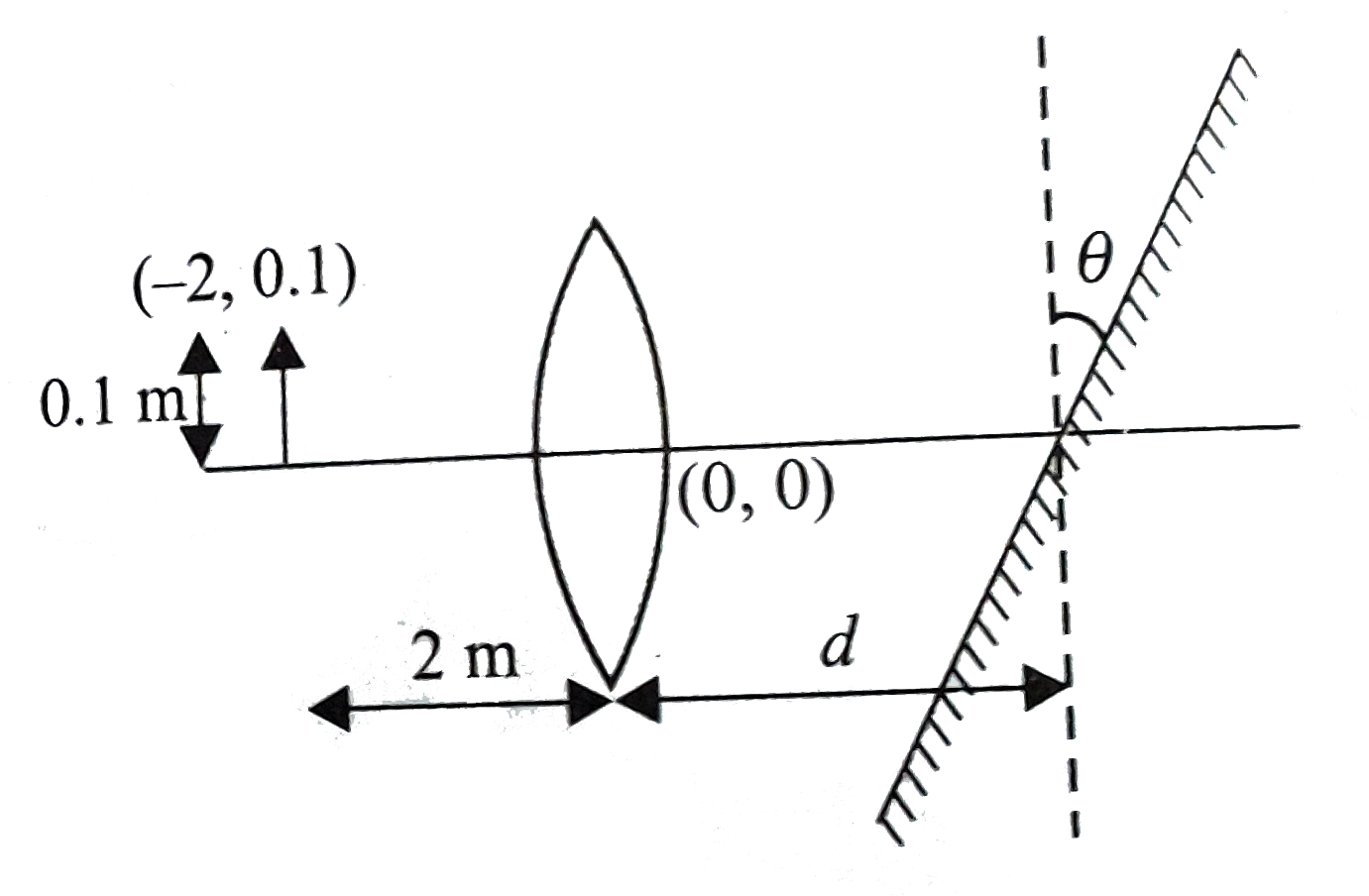
View Solution
Level 2 Subjective questions and complete solutions for chapter REFRACTION OF LIGHT of DC PANDEY ENGLISH of Class 12
All Exercises from DC PANDEY Class 12 PHYSICS REFRACTION OF LIGHT
- Example
- Example Type 10
- Example Type 11
- Exercise 31.1
- Exercise 31.2
- Exercise 31.4
- Exercise 31.5
- Exercise 31.6
- Exercise 31.7
- Exercise 31.8
- Introductory exercise
- Level 1 Assertion And Reason
- Level 1 Objective
- Level 1 Subjective
- Level 2 Comprehension Based
- Level 2 More Than One Correct
- Level 2 Single Correct
- Level 2 Subjective
- more than one correct option
- Objective Questions
- Single Correct Option
- Solved Example
- Subjective Questions